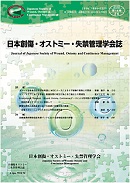Volume 19, Issue 4
Displaying 1-5 of 5 articles from this issue
- |<
- <
- 1
- >
- >|
Original Article
-
2015Volume 19Issue 4 Pages 365-377
Published: 2015
Released on J-STAGE: April 30, 2021
Download PDF (649K) -
2015Volume 19Issue 4 Pages 378-385
Published: 2015
Released on J-STAGE: April 30, 2021
Download PDF (419K) -
2015Volume 19Issue 4 Pages 386-393
Published: 2015
Released on J-STAGE: April 30, 2021
Download PDF (421K) -
2015Volume 19Issue 4 Pages 394-402
Published: 2015
Released on J-STAGE: April 30, 2021
Download PDF (359K)
Report
-
2015Volume 19Issue 4 Pages 403-409
Published: 2015
Released on J-STAGE: April 30, 2021
Download PDF (424K)
- |<
- <
- 1
- >
- >|
